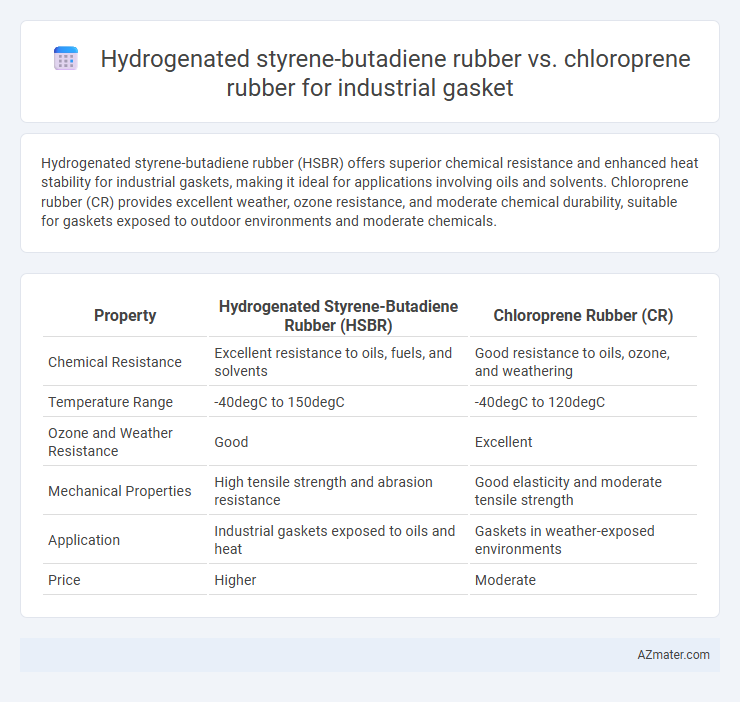Hydrogenated styrene-butadiene rubber (HSBR) offers superior chemical resistance and enhanced heat stability for industrial gaskets, making it ideal for applications involving oils and solvents. Chloroprene rubber (CR) provides excellent weather, ozone resistance, and moderate chemical durability, suitable for gaskets exposed to outdoor environments and moderate chemicals.
Table of Comparison
| Property | Hydrogenated Styrene-Butadiene Rubber (HSBR) | Chloroprene Rubber (CR) |
|---|---|---|
| Chemical Resistance | Excellent resistance to oils, fuels, and solvents | Good resistance to oils, ozone, and weathering |
| Temperature Range | -40degC to 150degC | -40degC to 120degC |
| Ozone and Weather Resistance | Good | Excellent |
| Mechanical Properties | High tensile strength and abrasion resistance | Good elasticity and moderate tensile strength |
| Application | Industrial gaskets exposed to oils and heat | Gaskets in weather-exposed environments |
| Price | Higher | Moderate |
Overview of Industrial Gasket Materials
Hydrogenated styrene-butadiene rubber (HSBR) offers superior heat resistance and excellent mechanical properties, making it ideal for industrial gaskets in high-temperature environments. Chloroprene rubber (CR) provides outstanding chemical resistance and weatherability, suitable for gaskets exposed to oils, solvents, and outdoor conditions. Choice between HSBR and CR depends on specific industrial requirements such as temperature range, chemical exposure, and mechanical stress.
Chemical Structure Comparison: HSBR vs. CR
Hydrogenated styrene-butadiene rubber (HSBR) features a saturated polybutadiene backbone with hydrogenation reducing unsaturation, enhancing its chemical resistance and thermal stability. Chloroprene rubber (CR) contains chlorine atoms attached to its polymer chain, offering inherent flame resistance and resistance to oils and ozone. The presence of chlorine in CR provides superior chemical stability in harsh environments, while the hydrogenation in HSBR offers improved aging resistance and lower gas permeability, making each suitable for specific industrial gasket applications.
Mechanical Properties: Strength, Flexibility, and Durability
Hydrogenated styrene-butadiene rubber (HSBR) offers superior tensile strength and excellent resistance to abrasion, making it ideal for industrial gaskets requiring high mechanical durability. Chloroprene rubber (CR) provides enhanced flexibility and good resistance to weathering, ozone, and chemicals, ensuring gasket performance under varied environmental conditions. HSBR outperforms in high-temperature stability and chemical resistance, while CR maintains consistent elasticity and mechanical integrity in harsh outdoor applications.
Resistance to Oils, Chemicals, and Solvents
Hydrogenated styrene-butadiene rubber (HSBR) exhibits superior resistance to oils, chemicals, and solvents due to its saturated backbone and enhanced thermal stability, making it ideal for industrial gaskets exposed to aggressive hydrocarbons and petroleum-based fluids. Chloroprene rubber (CR) offers good general chemical resistance and weatherability but is less effective than HSBR when exposed to strong oils and solvents, often showing swelling and degradation over time. For industrial gasket applications requiring high durability against oils and harsh chemicals, HSBR provides better performance and longevity compared to chloroprene rubber.
Temperature Stability and Heat Aging Performance
Hydrogenated styrene-butadiene rubber (HSBR) demonstrates superior temperature stability with an operational range up to 150degC, outperforming chloroprene rubber (CR), which typically withstands temperatures up to 120degC. HSBR exhibits excellent heat aging performance due to its saturated polymer backbone, resulting in minimal degradation and extended service life in high-temperature environments. Chloroprene rubber offers moderate heat aging resistance but tends to harden and crack faster under prolonged thermal exposure compared to HSBR, making HSBR a preferred choice for industrial gaskets requiring enhanced durability.
Ozone and Weathering Resistance
Hydrogenated styrene-butadiene rubber (HSBR) offers superior ozone and weathering resistance due to its saturated polymer backbone, which significantly reduces susceptibility to oxidative degradation compared to chloroprene rubber (CR). Chloroprene rubber exhibits moderate ozone resistance, but its polychloroprene structure can degrade faster under prolonged exposure to UV radiation and harsh weather conditions. For industrial gaskets requiring long-term durability in outdoor or ozone-rich environments, HSBR provides enhanced performance and extended service life.
Compression Set and Sealing Efficiency
Hydrogenated styrene-butadiene rubber (HSBR) exhibits superior compression set resistance compared to chloroprene rubber, retaining elasticity under prolonged stress and maintaining effective sealing in industrial gasket applications. Chloroprene rubber offers enhanced chemical and weather resistance but typically shows higher compression set values, leading to potential leakage over time in high-pressure sealing environments. For industries prioritizing long-term sealing efficiency and minimal deformation, HSBR provides a more reliable gasket material choice due to its balanced mechanical properties and durability.
Cost-Effectiveness and Availability
Hydrogenated styrene-butadiene rubber (HSBR) offers superior chemical resistance and durability at a relatively lower cost, making it a cost-effective option for industrial gaskets in applications requiring fuel and oil resistance. Chloroprene rubber (CR), known for its excellent weather, ozone, and flame resistance, tends to have higher raw material costs and limited availability compared to HSBR, impacting overall manufacturing expenses. The widespread availability of HSBR and its balance of performance and pricing provide significant advantages for large-scale industrial gasket production.
Environmental Impact and Recycling Potential
Hydrogenated styrene-butadiene rubber (HSBR) offers superior resistance to oxidation and heat aging, enhancing gasket longevity and reducing environmental waste through less frequent replacements, while its partially saturated polymer structure allows moderate recyclability. Chloroprene rubber (CR), derived from chlorinated monomers, exhibits excellent chemical and ozone resistance but poses greater environmental challenges due to halogenated compounds that complicate recycling and increase the potential release of toxic residues. The recycling potential of HSBR is generally higher with established mechanical and chemical recycling methods, whereas CR's recycling is limited and often requires specialized treatment to mitigate environmental impact in industrial gasket applications.
Application Suitability: HSBR vs. CR in Industrial Gaskets
Hydrogenated styrene-butadiene rubber (HSBR) offers superior chemical resistance, heat stability, and low gas permeability, making it suitable for industrial gaskets in harsh chemical environments and elevated temperatures. Chloroprene rubber (CR) exhibits excellent ozone, weather, and oil resistance with good mechanical strength, ideal for outdoor or oil-exposed gasket applications. HSBR is preferred in applications requiring enhanced thermal and chemical durability, while CR is favored for gaskets exposed to weathering and petroleum-based fluids.

Infographic: Hydrogenated styrene-butadiene rubber vs Chloroprene rubber for Industrial Gasket
 azmater.com
azmater.com